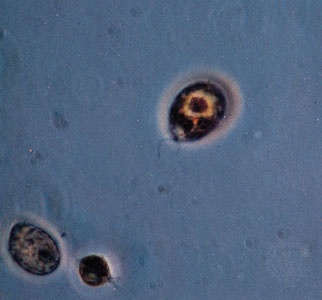Chlamydomonas
genus of algae
 genus of green biflagellated single-celled organisms of disputed classification, placed botanically in the green algal order, Volvocales, and zoologically in the plantlike protozoan order, Volvocida. Chlamydomonas is considered a primitive life-form of evolutionary significance. The more or less oval cells have a cellulose membrane (theca), a stigma (eyespot), and a usually cup-shaped, pigment-containing chloroplast. Although photosynthesis occurs, nutrients also may be absorbed through the cell surface. Asexual reproduction is by zoospores; sexual reproduction is by formation of gametes. The development of motility, sexual differentiation, and gamete fusion seems dependent on the production of substances (termones, gamones) that have a regulatory action similar to hormones. There are some 500 species of Chlamydomonas, found in soil, ponds, and ditches, where they may colour water green. One species, C. nivalis, which contains the red pigment hematochrome, sometimes imparts a red colour to melting snow.
genus of green biflagellated single-celled organisms of disputed classification, placed botanically in the green algal order, Volvocales, and zoologically in the plantlike protozoan order, Volvocida. Chlamydomonas is considered a primitive life-form of evolutionary significance. The more or less oval cells have a cellulose membrane (theca), a stigma (eyespot), and a usually cup-shaped, pigment-containing chloroplast. Although photosynthesis occurs, nutrients also may be absorbed through the cell surface. Asexual reproduction is by zoospores; sexual reproduction is by formation of gametes. The development of motility, sexual differentiation, and gamete fusion seems dependent on the production of substances (termones, gamones) that have a regulatory action similar to hormones. There are some 500 species of Chlamydomonas, found in soil, ponds, and ditches, where they may colour water green. One species, C. nivalis, which contains the red pigment hematochrome, sometimes imparts a red colour to melting snow.- Anicius Manlius Severinus Boethius
- aniconism
- Anielewicz, Mordecai
- Aniene River
- Aniliidae
- aniline
- animal
- animal behaviour
- animal breeding
- animal communication
- animal development
- animal disease
- Animal diseases usually confined to certain regions of the world
- animal interlace
- animal learning
- animal magnetism
- animal reproductive system
- animal rights
- animals, master of the
- Animals, the
- animal worship
- animation
- Animikie Series
- animism
- Animuccia, Giovanni